An Investigation of the Outcomes of Stroke Patients in The Community: Is it Possible to Recovery Well after Golden Rehabilitation Period
Chiu Wen Hsi1*, Wang Su Feng2, Yu-Ju Hsieh3, Wang Hsin Min4
1Department of Nursing, Mackay Junior College of Medicine, Nursing and Management School, No.92, Shengjing Rd, Beitou Dist, Taipei City 112, Taiwan.
2Associate professor, Tzu Chi University of Science and Technology, Taiwan.
3Shin Kong Wu Ho-Su Memorial Hospital, Taiwan.
4MD & President, liu Shun clinic, Taiwan.
*Corresponding Author: Chiu Wen Hsi, Department of Nursing, Mackay Junior College of Medicine, Nursing and Management School, No.92, Shengjing Rd., Beitou Dist., Taipei City 112, Taiwan, Tel: 00886-2-28584180-2225; Fax: 00886-2-28584180-2225; E-mail:anniec3636@gmail.com
Citation: Chiu Wen His, Wang Su Feng, Yu-Ju Hsieh, Wang Hsin Min(2020) An Investigation of the Outcomes of Stroke Patients in The Community: Is it Possible to Recovery Well after Golden Rehabilitation Period.J Nursing Palliat serv 2: 110.
Copyright: © 2022 Chiu Wen Hsi, et al. This is an open-access article distributed under the terms of the Creative Commons Attribution License, which permits unrestricted use, distribution, and reproduction in any medium, provided the original author and source are credited.
Received: May 04, 2022; Accepted: May 12, 2022; Published: May 15, 2022.
Abstract
Stroke is the fourth leading cause of death in Taiwan and is the main cause of disability globally. Chiou [1] stated that the disability of patients with stroke is about 60% after one month, and about 50-55% for 3~6 months after stroke. Yang, et al. [2] address most of the stroke people whose aged 65 and over are cared for at home, but the frequency of rehabilitation care for these elderly is the lowest. Community-based care is another way to look after stroke patients in long-term condition. Currently, little is known about community clinic care of stroke patients when the patients returned home from the hospital. The purpose of this study is to analyze the patient data of a community clinic to understand the outcome of the care of stroke patients. A retrospective study which reviewed the stroke patients’ charts in a community clinic was adopted. Data were collected from 2011 to 2016. 389 patients’ data were showed in this study. The result showed that the improvement of stroke patients in the upper limbs and lower limbs is the most significant, and its progress can reach nearly 75~80%. Moreover, the slurred speech of this group can be improved by about 20%. Although the symptoms of drooling and choking were also improved, the progress is about 10~15%. This result indicates that the community clinic care may be another way to facilitate the progress of stroke patients after transition from the hospital to the home.
Background
Stroke, known as cerebrovascular accident, is mainly caused by blood vessels to block or blood vessels to rupture in the brain, resulting in a lack of blood supply to the brain, insufficient oxygen, and lack of nutrition of brain tissue. It is the main cause of death and disability in the global population and is the fourth leading cause of death in Taiwan. According to the World Health Organization (WHO), about 17.5 million people died of cardiovascular disease in 2012, and 6.7 million of them died of stroke. The lifetime incidence of stroke is one-sixth. According to the statistics of the Ministry of Health and Welfare [3], a total of 11,846 lives were taken by stroke, and one person died of stroke in every 44 minutes. The results show that the stroke is more common in people whose age over 60, and men were more likely to suffer from stroke than women.
People with stroke may cause brain damage and it may produce different functional disorders due to different lesion sites, such as upper limbs or lower limbs dysfunction, slurred speech, drooling and choking etc. Disability sequela is also one of the main causes of adult disability in Taiwan. It not only causes a heavy burden on patients and caregivers, but also seriously affects their quality of life. In 2017, the World Stroke Organization emphasizes risk awareness and prevention of stroke. According to the Taiwan Stroke Registry, the rate of disability of a first-time stroke patient after 1 month of stroke was 61.2%, 3 months was 55.58%, and half a year was 51.72% [1,4]. At present, the care for stroke patients includes hospital treatment, such as t-PA within three hours, observation and care in the stroke center, and then rehabilitation and follow-up care after the patient's condition is stable. Most of the study focused on the hospital care and small community hospital care from the perspective of the professionals’ view [5-7]. Few study focused on the outcomes of community clinics care when the patients return home. There is a need to understand how patients are looked after when they return home and what their progress improves during the long-term condition.
Clinically, stroke can be divided into two categories, ischemic stroke and hemorrhagic stroke, regardless of hemorrhagic or ischemic brain damage, stroke can lead to different degrees of disability. Chiou [1] addressed the disability of patients is about 60% after one month of stroke, and about 50-55% from 3 to 6 months after stroke. No matter which type or degree of stroke, it needs variety of care in the acute and sub-acute phases [1]. Some research already demonstrated that stroke may cause patients have social and psychological deficits such as depression or lack of social interaction due to functional impairments [8-10], most of stroke patients may need continuity of care when they return home from the hospital [9]. Since 2014, the Department of Health Insurance has been carried out a project of caring for stroke patients after acute stage, it is hoped that patients with acute stroke will receive treatment during their first month of stroke in the hospital, and then if their condition becomes stable, they can get a multi-disciplinary team care and return to the community soon. The patient can be properly cared for within three months of rehabilitation after acute stroke, and their disability may be slowed down. However, few research has been conducted to understand the outcomes of community recovery in stroke patients when they return home; therefore, it is important to be able to understand how patients were cared for when they return home. It can shed a light for the continuity and long-term care of stroke patients after acute stage.
The impairment of stroke varies depending on the injured part, which can lead to physical or mental impairment of the patient, such as functional impairment, movement deterioration, swallowing dysfunction, sensory disturbances, speech disorders, cognitive dysfunction, visual impairment, defecation, dysuria and mood disorders etc. [11,12]. Due to advances in stroke treatment, about one-third of patients can improve their disability after treatment, but about two-thirds of patients still have varying degrees of impairments in physical function, cognitive and behavioral functions. The literature points out that patients with stroke can moderately improve the degree of physical disability through certain rehabilitation and health education is important for these patients [13-15] (Zhang, Hui, Jiang, Zhuang, Guo, 2014), however, there is still a need to continue to rehabilitate in community hospitals or regional hospitals when patients return home in the community to improve the deterioration of physical function. Some scholars have pointed out that since 2008, patients with stroke in Taiwan have become younger [16]. The statistics of the Ministry of Health and Welfare of the Executive Yuan also pointed out that the number of deaths caused by stroke has decreased (Executive Health and Welfare Department, 2016), it is obvious that the number of middle-aged and elderly patients who remain in the community or long-term institutions has increased year by year. Yang, Zheng, Lin, Fang and Ding [2] used the health insurance database analysis to address that most of the stroke patients, whose aged 65 and over, were care for at home in Taiwan, but the frequency of rehabilitation care for these elderly at home is the lowest. This report indicated there is a need to understand the care of sub-acute to chronic phase of home care in the community.
Many patients with stroke often seek other related care to alleviate physical dysfunction after being treated in a hospital. Currently, little is known about home-based care of stroke patients in the community. Therefore, the main purpose of this study is to analyze the patient data of community clinics and to understand the outcome of community clinic care of stroke patients' recovery as a reference for future long-term care. The aim of this study is to understand the outcomes of the community clinic care of stroke patients and it’s effective of improvement of patients’ symptoms.
Method
This is a retrospective study which reviewed and analyzed stroke patients’ assessment recordings and charts in a community clinic. For selection of a sample, the inclusion and exclusion based around the patients whose age were over 20, suffered from stroke, came to the clinic at least twice a week and needed for the care were recruited in this study. Patients whose age were under 20, and did not suffer from stroke, came to the clinic less than twice 1aweek were excluded in this study. The period of assessment recordings and charts review were from January 2011 to December 2016. Data and information coded to provide personal data of patients and for identification were removed. The Ethical approval was sought and was obtained from the Institutional Review Board of Siin Kong Wu Ho-Su Memorial Hospital. 606 patients’ recordings and charts have been reviewed by two registered nurses, only 389 patients’ data were recruited in this study. The 217 patients were excluded because they only came to the clinic once and there was not sufficient information for these patients.
Data collection
This study reviewed the outcome before and after the care of stroke patients to figure out their outcome and progress after a community clinic care. The data collection included pre-care, 1st time care to 5th time care. The period was chosen because it was necessary to understand the patient's progress before, during, and after care. Some patients might increase the number of times due to different conditions, which was not discussed in this study. The community clinic care was carried out by 6-shun medical team which included the doctor’s assessment and education of the patients two to three times a week. The assessment and education included understanding the patient's medication status, common symptoms, the implementation and correctness of the home rehabilitation exercise, current difficulties, etc. Moreover, the directed inspection of patients’ progress of common symptoms, the implementation and correctness of the home rehabilitation exercise was carried out from three trained case managers. All of the patients’ records were carried out by the 6-shun medical team. All the case managers have been trained how to evaluate the stroke patients’ progress. The case managers confirm whether the stroke patient has followed the doctor's instructions for rehabilitation exercise and doing the exercise right or wrong. This study adopted a self-report recording of the common symptoms of stroke patients as an evaluation tools. It included functional improvement of upper limbs and lower limbs, the change of slurred speech, and the progress of drooling and choking. The patient was assessed by the doctor and case managers before and after each time of the care. If the patient's upper limbs function well, he/she can get 1 point. If the upper limb function is not good, 0 point would be put in the chart. The highest score before the community clinic care is 5 points, and the lowest score is 0 points. Moreover, if the patient improves after taking care, he/she can get one point each time. This kind of scoring method was analogized to the other four symptoms. Finally, after five consecutive evaluations of different symptoms, use each symptom’s progress to understand the cumulative improvement of the patient. Indeed, the case manager assessed the patient's five major symptoms and discuss with the physician to achieve the consistency of patient care. The patient needed to come to the clinic 2-3 times a week to confirm that he/she has followed the physician’s instructions for home rehabilitation. Also the medical team needed to assess the patient's progress to confirm if there is a need to change care or rehabilitation. Although there are many clinical scales that can monitor the progress of patients, none of the scales contain all the common signs and symptoms to stroke, especially in the community clinic care. Therefore, this study adopted the self-report of the common signs and symptoms of stroke patient and to direct observation from the medical team to evaluate the outcome of these patients. It was hope to use this preliminary study to develop a better scale to understand how patients are being cared for in community clinics.
Data analysis
This study is to investigate the outcome of stroke patients in the community clinic care. SPSS WIN version 24 was used to analyze the data. Percentage, mean and standard deviation were included in the descriptive data analysis. This study used the chi-square test to understand the progress of pre-care, first care and fifth care of the patient. p
Result
A number of 606 patients’ recordings and charts have been reviewed and 389 patients’ data were showed in this study. The 217 patients were not recruited because they only came to the clinic once for prevention and their information of progress could not be used as a standard for evaluation.
The basic information of the 389 patients was showed in Table 1. The average age of the patient was 69.76±12.26 years old. There are 137 patients under the age of 65, 103 patients aged between 65 to 75, and 149 patients over the age of 75. The average days after a stroke to a community clinic was 160.38±344.82 days. 236 (60.7%) patients were male and 153 (39.3%) patients were female. The type of stroke in patients included 321(82.5%) patients with embolic type and 65 (16.7%) patients with hemorrhagic type. Only three patients (0.8%) had both occurred. Most of the strokes (43.2%) were taken care of by family members or relatives, 41(10.5%) patients were looked after by care workers or by self and only few patients (3.6%) lived in a nursing home or a care home. Among the stroke patients, 321 (82.5%) patients had their first stroke, 68 (17.5%) patients had twice or more stroke before. In 389 patients, 355 (91.3%) had hypertension, 213 (54.8%) had diabetes, 205 (52.7%) had high triglyceride and cholesterol, 61 (15.7%) had a history of heart disease, and 147 (37.8%) had other diseases such as stomach or liver disease etc. The demography information of these patients were showed in Table 1.
Table 1: Demography of the patients (N=389).
|
? |
N |
Min. | Max. |
Mean+SD |
|
average age of stroke patients |
389 |
28 |
96 |
69.76±12.26 |
|
Days of stroke before to the clinic |
389 |
1 |
2972 |
160.38±344.82 |
|
sex |
No. |
percentage |
|
male |
236 |
60.7 |
|
female |
153 |
39.3 |
|
age |
No. |
percentage |
|
137 |
35.2 | |
|
65-75 years old |
103 |
26.5 |
|
>75 years old |
149 |
38.3 |
|
Caregivers/Guardians |
No. |
percentage |
|
relatives |
168 |
43.2 |
|
Care workers |
21 |
5.4 |
|
self |
20 |
5.1 |
|
nursing home or care home |
14 |
3.6 |
|
no described |
166 |
42.7 |
|
types of stoke |
No. |
percentage |
|
Embolism |
321 |
82.5 |
|
hemorrhage |
65 |
16.7 |
|
both |
3 |
0.8 |
|
occurrence of stroke |
No. |
percentage |
|
once |
321 |
82.5 |
|
More than once |
68 |
17.5 |
|
Days during 1st admission |
No |
percentage |
|
318 |
81.7 | |
|
?180 days |
71 |
18.3 |
|
|
|
|
|
medical history |
No. |
percentage |
|
HTN |
355 |
91.3 |
|
DM |
213 |
54.8 |
|
TgTc |
205 |
52.7 |
|
Heart Disease |
61 |
15.7 |
|
Other disease |
147 |
37.8 |
Table 2 compares the progress of patients after 5 times of community clinic care. From the table, we can see that the patients have improved in the first to fifth treatments. However, the results of the second to third, and the third to fourth progress were less significant, perhaps it was because the patient's time from the last assessment and observation was shorter, therefore the progress was not obvious. Therefore, we further analyzed the original data. The patient's progress in different symptoms was analyzed. Figure 1 shows that the patient had the greatest improvement after first care. Each symptom progressed after five traces, except for the lower limbs. In addition, after understanding the improvement status of each sub-item, using the cumulative improvement rate to understand the cumulative progress of each sub-item of the patient, it was found that if the clinic continued to provide care and follow-up of the patient, their progress of symptoms were gradually increased. This result was shown in Figure 2. Figure 3-7 analyzes the progress of each sub-item of the patient. The analysis showed that the improvement of the upper limbs and lower limbs is the most significant, and its progress can reach nearly 75~80%. Moreover, the slurred speech can be improved by about 20%. Although the symptoms of drooling and choking were also improved, the progress is about 10~15%.
Table 2: comparison of Improvement between each care (chi-square).
|
? |
value |
df |
P value(2-sided) |
significant |
|
comparison of Improvement between 1st and 2nd care |
44.44 |
1 |
<0.0001 |
**** |
|
comparison of Improvement between 1st and 3nd care |
67.86 |
1 |
<0.000001 |
**** |
|
comparison of Improvement between 1st and 4nd care |
92.17 |
1 |
<0.00001 |
**** |
|
comparison of Improvement between 1st and 5nd care |
104.1 |
1 |
<0.0001 |
**** |
|
comparison of Improvement between 2nd and 3rd care |
3.17 |
1 |
0.075 |
|
|
comparison of Improvement between 2nd and 4th care |
11.91 |
1 |
0.00056 |
*** |
|
comparison of Improvement between 2nd and 5th care |
17.95 |
1 |
0.000023 |
**** |
|
comparison of Improvement between 3rd and 4th care |
2.968 |
1 |
0.085 |
|
|
comparison of Improvement between 3rd and 5th care |
6.544 |
1 |
0.011 |
* |
|
comparison of Improvement between 4th and 5th care |
0.7479 |
1 |
0.387 |
|
Figure 1:

Figure 2:
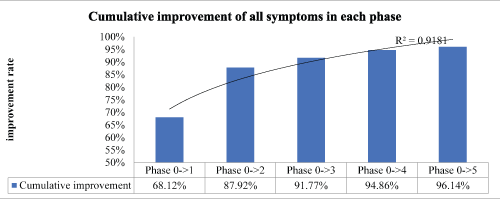
Figure 3:
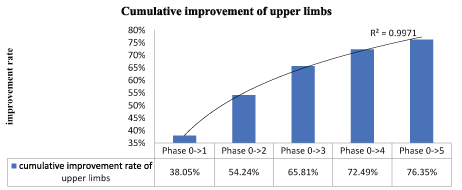
Figure 4:
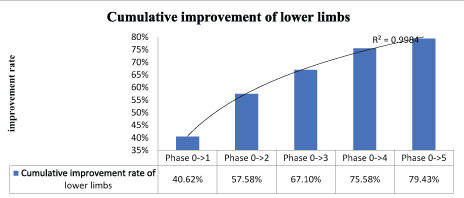
Figure 5:
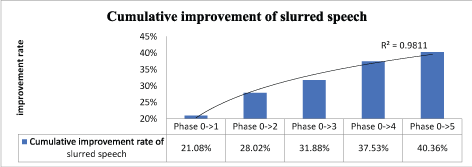
Figure 6:
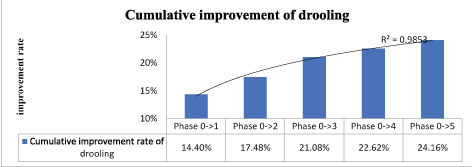
Figure 7:
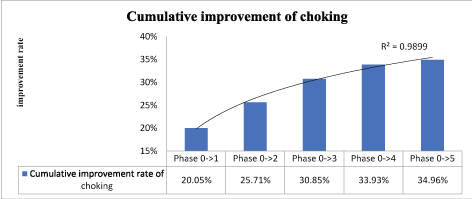
Discussion
The result of this study provides a clear picture of the community based clinic care was effective for stroke patients. Song and Li [17] indicated patients and their caregivers needed proper information to perform the care of stroke patients. Reeves et al. [10] design the Michigan stroke transitions trial (MISTT) protocol to improve the transitions in acute stroke patients discharged to home, their study showed if a home-based care in combination with the information designed with the needs of the patients, it can improve the outcome of stroke patients when they return home within 3 months. This is the same of the same of this study. In this study, the 6-shun medical team carried out a close inspection of the patient’s outcome when they go to the community clinic after discharge from the hospital. During the inspection and observation period, the physicians and case managers perform discussions with the patients of their care plans, this can provide more sufficient care for the needs of the patients. Through the discussion process, the difficulties of care may emerge and the relevant solution will be seek to sort out the problem. It is recommended that the government must develop a national discharge planning policy which need to include the involvement of hospital and community clinic staff and stroke patients and their caregivers. A complication of information pack should be ready for stroke patients and their caregivers of how to manage care after discharge, where they can get rehabilitation and care in the community clinics, what to notice when the patient is home, and how to find the resources. Person-centered care is said to be an approach to service delivery and service development, ensuring that service are developed in partnership with people and their caregivers [18]. This should be happened in both hospital and community. Stroke patients need multi-disciplinary team and its coordination of rehabilitation and home-based care is challenging. Pound et al. [19] identified that stroke patients’ needs were not meet after transition their lives at home and Sabari et al. [20,21] indicated stroke patients needed not only functional care but also psychosocial and spiritual care. A community clinic care may be a best way to provide this care for patients after stroke. From this study, the cumulative improvements showed advancement of functional progress of stroke patients can be promoted through close follow-up care. However, the psychosocial and spiritual needs may need more study to understand how it improves or impact on the patients’ lives. It is vital to conduct a qualitative study of psychosocial and spiritual need of stroke patients and their caregivers. It would provide a better understanding of outcome of stroke patients and their caregivers.
As clear at the start of the care, most of the patients were improved. However, the progress of the patient is not large during the 2~3 phase, and even some people are regressing. This may be because we look at the progress of each item separately. If the overall evaluation is made, the progress of the patient is obvious. In addition, some patients may deteriorate and did not come to the community clinic regularly, this may explain why some of the phases were not significantly improved a lot. It is also an unavoidable factor of omission after care and evaluation, such as patients improve a lot within three phases and patients’ conditions become worse and returned to the hospital.
Conclusion
The result of this study revealed the outcome of stroke patients in community clinic care. It is also showed that the community clinic follow-up can improve the outcomes of stroke patients. Stroke care currently focuses mainly on acute hospital care and inpatient rehabilitation, however, there is clearly a role to expend community clinic care. This seem to be an essential component in the realm of person-centered care of stroke patients.
Recommendation
There is a need for further research to understand the current process of caring for this group in the community and how their transition from hospital to community and home, and who had been informed and what information they get. This would help to plan for further intervention in discharge planning for this group.
References
- Chiou H-Y (2015) The current situation and future of subacute and long-term care~ Take stroke as an example. Taiwan Stroke Society Journal 22: 4-7.
- Yang HC, Cheng TY, Lin SH, Fang CL, Ting TH, et al. (2017) Utilization of outpatient Rehabilitation for Disabled Elderly Stroke Patients in Different Care Settings and its Implications for Long-Term Care Policy. Journal of Health management 9: 1-16.
- Ministry of Health and Welfare (2016) 2016 Report of health?
- Kwakkel G, Wagenaar RC, Kollen BJ, Lankhorst GJ (1996) Predicting Disability in Stroke-A critical Review of the Literature. Age and Ageing 26: 479-489.
- Tholin H, Forsberg A (2014) Satisfaction with care and rehabilitation among people with stroke, from hospital to community care. Scand. Journal of caring Science 28: 822-829.
- Lau C, Chitussi D, Elliot S, Giannone J, McMahon M-K, et al. (2016) Facilitating Community-Based Exercise for People With Stroke: Cross-Sectional e-Survey of Physical Therapist Practice and Perceived Needs. Physical Therapy Journal 96: 469-478.
- Tang EYH, Price C, Stephan BCM, Robinson L, Exley C, et al. (2017) Gaps in care for patients with memory deficits after stroke: view of healthcare providers. BMC Health Services Research 17: 634-643.
- McKevitt C, Redfern J, Mold F, Wolfe C (2004) Qualitative studies of stroke: a systematic review. Stroke 35: 1499-1505. [crossref]
- Hill KM, Twiddy M, Hewison J, House AO (2014) Measureing patient-perceived continuity of care for patient with long-term conditions in primary care. BMC Family Practice15: 191-205.
- Reeves MJ, Hughes AK, Woodward AT, Freddolino PP, Coursaris CK, et al. (2017) Improving transitions in acute stroke patients discharged to home: the Michigan stroke transitions trial (MISTT) protocol. BMC Neurology 17: 115-130.
- Pumpa L U, Cahill LS, Carey L M (2015) Somatosensory assessment and treatment after stroke: An evidence-practice gap. Australian Occupational Therapy Journal 62: 93-104.
- Szu L-Y, Hsieh S-I, Tseng S-M, Huang T-H (2017) The determinants od Dysphagia in Patients with Stroke During Hospitalized Rehabilitation. The Journal of Nursing 64: 43-55.
- Oujamaa L, Relave I, Froger J, Mottet D, Pelissier JY, et al. (2009) Rehabilitation of arm function after stroke. Literature review. Annual Physical Rehabilitation Medicine 52: 269-293.
- Chi Y-H, Wu C-L, Lee C-S, Chang W-P, Hsu C-C, et al. (2013) The Effect of Health Education on the Psychosocial Outcomes for Patients with Minor Stroke. Taipei City Medical Journal 10: 26-37.
- Ru X, Dai H, Jiang B, Zhao X, He L, et al. (2017) Community-Based Rehabilitation to Improve Stroke Survivors' Rehabilitation Participation and Functional Recovery. American Journal of Physical Medicine Rehabilitation 96: e123-e129.
- Chiou H-Y (2008/2009) Current status and epidemiological characteristics of stroke. Taiwan Stroke Society Journal 15: 2-4.
- Song J-M, Li M-D (2015) Discussion on the needs of elderly home stroke patients for long-term home care - from the perspective of primary caregivers. Journal of Gerontechnology 3: 369-370.
- McCormack B (2003) A conceptual framework of person-centred practice with older people. International Journal of Nursing practice9: 202-209.
- Pound P, Bury M, Gompertz P, Ebrahim S (1994) Views of survivors of stroke on benefits of physiotherapy. Qualitative Health Care 3 69-74.
- Sabari S J, Meisler J, Silver E, Reflections upon rehabilitation by members of a community based stroke club. Disability Rehabilitation22: 330-336.
- Chang YJ, Hu GC, Chiang YP, Chuang YC, Kuo CL, et al. (2014) Association between the Amount of Inpatient Rehabilitation Therapy and the Risk of Disability and Mortality in Patients with Ischemic stroke. Taiwan rehabilitation medicine 42: 191-198.
